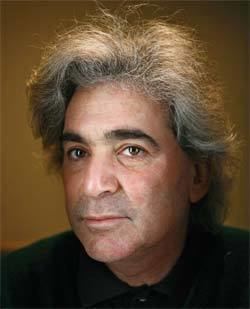Nationality American Role Biologist | Name Michael Levine Fields Developmental biology | |
 | ||
Institutions Princeton UniversityUniversity of California, BerkeleyUniversity of California, San DiegoColumbia University Residence Berkeley, California, United States Books Julia: Nothing Lasts Forever | ||
Cshl keynote dr michael levine uc berkeley
Michael Levine is an American developmental and cell biologist at Princeton University, where he is the Director of the Lewis-Sigler Institute for Integrative Genomics and a Professor of Molecular Biology.
Contents
- Cshl keynote dr michael levine uc berkeley
- Biography
- Homeobox discovery
- Discovery of the eve stripe 2 enhancer
- Discoveries in the ascidian Ciona
- Awards
- Professional relations
- Training
- Notable papers
- References
Levine previously held appointments at the University of California, Berkeley, the University of California, San Diego, and Columbia University. He is notable for co-discovering the Homeobox in 1983 and for discovering the organization of the regulatory regions of developmental genes.
Biography
Levine was born in West Hollywood and raised in Los Angeles. Levine studied biology as an undergraduate at UC Berkeley, studying biology with Allan Wilson and graduating in 1976. He went on to graduate studies at Yale, where he studied with Alan Garen and in 1981 received a Ph.D. in molecular biophysics and biochemistry.
Levine joined the Princeton faculty in 2015, and had been a professor at UC Berkeley after leaving UCSD in 1996.
Homeobox discovery
Levine was a post-doc with Walter Gehring in Switzerland from 1982 to 1983. There, he co-discovered the homeobox with Ernst Hafen and fellow post-doc William McGinnis:
After learning that Ultrabithorax, a gene that specifies the development of wings, showed a localized pattern of expression similar to that of Antennapedia, they decided to revisit the classic papers of Ed Lewis. In 1978, Lewis had proposed that all these homeotic genes (the ones that tell animals where to put a wing and where to put a leg and so on) arose from a common ancestral gene. So McGinnis carved up the Antennapedia gene and, using those pieces as probes, the trio identified eight genes, which turned out to be the eight homeotic genes in flies. "That pissed off a lot of people," says Levine. "The homeotic genes were the trophies of the Drosophila genome. And we got 'em all. I mean, we got 'em all!" Far from being humble, Levine says, "We were like, 'We kicked your ass pretty good, didn't we, baby!' Those were the days."
Discovery of the eve stripe 2 enhancer
Levine briefly returned to UC Berkeley as a postdoctoral fellow with Gerry Rubin. He then joined the faculty of Columbia University, where he "led the discovery of the modular organization of the regulatory regions of developmental genes." After isolating the even-skipped (eve) gene, Levine's team determined that each of the seven stripes was produced by separate enhancers. With further study they discovered that both a set of activators and a set of repressors worked together to shape the expression of eve in the second stripe, and determined that the repressors shut down only their binding enhancers, leaving other enhancers free of repression. Joseph Corbo said of the work,
"Before Levine's studies of even-skipped stripe 2, it wasn't clear how you generated spatially restricted patterns of gene expression from initially broad crude gradients of morphogens. I think that the even-skipped stripe 2 studies were the defining studies that showed how an organism can interpret those gradients and turn them into specific patterns of gene expression. To me that's Mike's crowning achievement."
Discoveries in the ascidian Ciona
After earning tenure in only four years at Columbia, Levine moved to UCSD in 1991, where he added the sea squirt, Ciona intestinalis, to his repertoire. Although much of Levine's work, including his homeobox studies, has been done in Drosophila Levine's team is also prominent in work with the sea squirt, Ciona intestinalis, an invertebrate that facilitates study of development. For example, this work included insights into classical myodeterminants and the composition of the notochord, the defining tissue of the chordate phylum.
Awards
Professional relations
Levine cites as a significant influence his instructor Fred Wilt (taking his developmental biology class "was probably the single most galvanizing experience I had in terms of defining my future goals"), and cites fellow scientists Eric Davidson, Peter Lawrence and Christiane Nusslein-Volhard as "mentors [and] friends ... over the years".
On choosing to become a research biologist, he described some family pressure to become a doctor ("Coming from a modest background, particularly a Jewish family, the pressure to become a doctor was intense"),
Fellow biologist Sean Carroll said of Levine, "Mike's work has done for animal development what the work on the lac operon and phage lambda did for understanding gene regulation in simpler organisms ... [Those] two big discoveries had a very large conceptual significance for developmental biology and by extension for evolutionary biology."
Levine is well-known within academic biologist circles for his unconventional sense of humor, including an incident in which he lit a ring of fire around a postdoc:
"The most famous thing I ever did is I torched one of my postdocs," says Levine. [Joseph] Corbo was there at the time. "Mike got a squirt bottle of ethanol, unbeknownst to this hapless postdoc who was sitting at his bench minding his own business," says Corbo. Levine shot a ring of ethanol around the young man's seat and trailed a wick into the hallway. Then he lit it. "So this tongue of flame snaked into the lab and encircled this postdoc," says Corbo. "My technique was a little off and I put a little too much ethanol around his bench. So it's true, he was temporarily enveloped in a curtain of fire," says Levine. "But the fire receded and he was ok."
Training
Levine has trained researchers in developmental biology and molecular biology. They include Stephen Small, professor of biology at New York University, and David Hendrix, assistant professor at Oregon State University, and Albert Erives, associate professor at University of Iowa.
